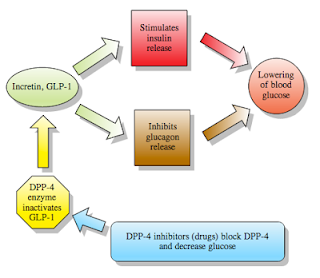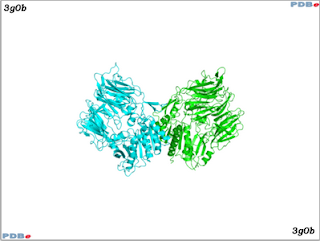New Drug Approvals 2013 - Pt. 1 - Alogliptin (NesinaTM)
On January 25th 2013, FDA approved Alogliptin (as the benzoate salt; tradename: Nesina; research code: SYR-322, TAK-322; CHEMBL: CHEMBL376359), a dipeptidyl peptidase-4 (DPP-4) inhibitor indicated as an adjunct to diet and exercise to improve glycemic control in adults with type 2 diabetes mellitus (also known as noninsulin-dependent diabetes mellitus (NIDDM)).
NIDDM is a chronic disease characterized by high blood glucose. In response to meals, increased concentrations of incretin hormones such as glucagon-like peptide-1 (GLP-1) and glucose-dependent insulinotropic polypeptide (GIP) are released into the bloodstream from the small intestine. These hormones cause insulin release from the pancreatic beta cells in a glucose-dependent manner but are inactivated by the DPP-4 enzyme within minutes. GLP-1 also lowers glucagon secretion from pancreatic alpha cells, reducing hepatic glucose production. In patients with NIDDM, concentrations of GLP-1 are reduced but the insulin response to GLP-1 is preserved. Alogliptin exerts its therapeutic action by inhibiting DPP-4, thereby slowing the inactivation of the incretin hormones and increasing their bloodstream concentrations.
Image from Wikipedia
Other DPP-4 inhibitors are already available on the market (some of which have already been covered here on the ChEMBL-og) and these include Linagliptin (approved in 2011 under the tradename Tradjenta; ChEMBL: CHEMBL237500; PubChem: CID10096344; ChemSpider: 8271879), Saxagliptin (approved in 2009 under the tradename Onglyza; ChEMBL: CHEMBL385517; PubChem: CID11243969; ChemSpider: 9419005) and Sitagliptin (approved in 2006 under the tradename Januvia; ChEMBL: CHEMBL1422; PubChem: CID4369359; ChemSpider: 3571948). Several other DPP-4 inhibitors are in clinical trials such as Trelagliptin (ChEMBL: CHEMBL1650443; research code: SYR-472), Omarigliptin (ChEMBL: CHEMBL2105762; research code: MK-3102), Carmegliptin (ChEMBL: CHEMBL591118; research code: R-1579, RO-4876904), Gosogliptin (ChEMBL: CHEMBL515387; research code: PF-734200), Dutogliptin (research code: PHX1149), Denagliptin (ChEMBL: CHEMBL2110666; research code: GW823093). Vildagliptin (ChEMBL: CHEMBL142703) has been approved in Europe and Japan, but not in the United States.
DPP-4 (ChEMBL: CHEMBL284; Uniprot: P27487) is 766 amino acid-long enzyme, which is responsible for the removal of N-terminal dipeptides sequentially from polypeptides having unsubstituted N termini, provided that the penultimate residue is proline. It belongs to the Dipeptidyl peptidase IV family (PFAM: PF00930).
The image above shows a crystal structure of DPP-4 (in this example, two copies of DPP-4 are displayed - PDBe: 3g0b). Information on the active site of DPP-4 can be found here.
Alogliptin is an oral small-molecule with a molecular weight of 339.4 Da (461.51 Da as the benzoate salt). The image on the right shows Alogliptin in the active site of DPP-4. Important features of its chemical structure are the aminopiperidine motif, which provides a salt bridge to the glutamic acids residues 205/206 in the active site of DPP-4, the cyanobenzyl group which interacts with the arginine residue 125, the carbonyl group from the pyrimidinedione moiety which participates in an hydrogen bond with the backbone NH of tyrosine 631 and the uracil ring which π-stacks with tyrosine 547.
IUPAC: 2-[[6-[(3R)-3-aminopiperidin-1-yl]-3-methyl-2,4-dioxopyrimidin-1-yl]methyl]benzonitrile
Canonical Smiles: CN1C(=O)C=C(N2CCC[C@@H](N)C2)N(Cc3ccccc3C#N)C1=O
InChI: InChI=1S/C18H21N5O2/c1-21-17(24)9-16(22-8-4-7-15(20)12-22)23(18(21)25)11-14-6-3-2-5-13(14)10-19/h2-3,5-6,9,15H,4,7-8,11-12,20H2,1H3/t15-/m1/s1
The recommended dosage of Alogliptin is 25 mg once daily. Alogliptin has good oral bioavailability F (approximately 100% bioavailable), with a volume of distribution Vd of 417 L and a low plasma protein binding (20%). Excretion is mainly renal (76% of the dose recovered in urine) and mostly as the parent compound (60% to 71%). Alogliptin is metabolized by CYP2D6 and CYP3A4 to two minor metabolites, M-I (N-demethylated alogliptin - >1% of the parent drug), which is an active metabolite and is an inhibitor of DPP-4 similar to the parent molecule and M-II (N-acethylated alogliptin - >6% of the parent drug), which does not display any inhibitory activity towards DPP-4 or other DPP-related enzymes. The renal clearance of Alogliptin is 9.6 L/hr and the systemic clearance is 14.0 L/hr.
The license holder is Takeda Pharmaceuticals America, Inc. and the prescribing information of Alogliptin can be found here.
Patricia
NIDDM is a chronic disease characterized by high blood glucose. In response to meals, increased concentrations of incretin hormones such as glucagon-like peptide-1 (GLP-1) and glucose-dependent insulinotropic polypeptide (GIP) are released into the bloodstream from the small intestine. These hormones cause insulin release from the pancreatic beta cells in a glucose-dependent manner but are inactivated by the DPP-4 enzyme within minutes. GLP-1 also lowers glucagon secretion from pancreatic alpha cells, reducing hepatic glucose production. In patients with NIDDM, concentrations of GLP-1 are reduced but the insulin response to GLP-1 is preserved. Alogliptin exerts its therapeutic action by inhibiting DPP-4, thereby slowing the inactivation of the incretin hormones and increasing their bloodstream concentrations.
Image from Wikipedia
Other DPP-4 inhibitors are already available on the market (some of which have already been covered here on the ChEMBL-og) and these include Linagliptin (approved in 2011 under the tradename Tradjenta; ChEMBL: CHEMBL237500; PubChem: CID10096344; ChemSpider: 8271879), Saxagliptin (approved in 2009 under the tradename Onglyza; ChEMBL: CHEMBL385517; PubChem: CID11243969; ChemSpider: 9419005) and Sitagliptin (approved in 2006 under the tradename Januvia; ChEMBL: CHEMBL1422; PubChem: CID4369359; ChemSpider: 3571948). Several other DPP-4 inhibitors are in clinical trials such as Trelagliptin (ChEMBL: CHEMBL1650443; research code: SYR-472), Omarigliptin (ChEMBL: CHEMBL2105762; research code: MK-3102), Carmegliptin (ChEMBL: CHEMBL591118; research code: R-1579, RO-4876904), Gosogliptin (ChEMBL: CHEMBL515387; research code: PF-734200), Dutogliptin (research code: PHX1149), Denagliptin (ChEMBL: CHEMBL2110666; research code: GW823093). Vildagliptin (ChEMBL: CHEMBL142703) has been approved in Europe and Japan, but not in the United States.
DPP-4 (ChEMBL: CHEMBL284; Uniprot: P27487) is 766 amino acid-long enzyme, which is responsible for the removal of N-terminal dipeptides sequentially from polypeptides having unsubstituted N termini, provided that the penultimate residue is proline. It belongs to the Dipeptidyl peptidase IV family (PFAM: PF00930).
>DPP4_HUMAN Dipeptidyl peptidase 4 MKTPWKVLLGLLGAAALVTIITVPVVLLNKGTDDATADSRKTYTLTDYLKNTYRLKLYSL RWISDHEYLYKQENNILVFNAEYGNSSVFLENSTFDEFGHSINDYSISPDGQFILLEYNY VKQWRHSYTASYDIYDLNKRQLITEERIPNNTQWVTWSPVGHKLAYVWNNDIYVKIEPNL PSYRITWTGKEDIIYNGITDWVYEEEVFSAYSALWWSPNGTFLAYAQFNDTEVPLIEYSF YSDESLQYPKTVRVPYPKAGAVNPTVKFFVVNTDSLSSVTNATSIQITAPASMLIGDHYL CDVTWATQERISLQWLRRIQNYSVMDICDYDESSGRWNCLVARQHIEMSTTGWVGRFRPS EPHFTLDGNSFYKIISNEEGYRHICYFQIDKKDCTFITKGTWEVIGIEALTSDYLYYISN EYKGMPGGRNLYKIQLSDYTKVTCLSCELNPERCQYYSVSFSKEAKYYQLRCSGPGLPLY TLHSSVNDKGLRVLEDNSALDKMLQNVQMPSKKLDFIILNETKFWYQMILPPHFDKSKKY PLLLDVYAGPCSQKADTVFRLNWATYLASTENIIVASFDGRGSGYQGDKIMHAINRRLGT FEVEDQIEAARQFSKMGFVDNKRIAIWGWSYGGYVTSMVLGSGSGVFKCGIAVAPVSRWE YYDSVYTERYMGLPTPEDNLDHYRNSTVMSRAENFKQVEYLLIHGTADDNVHFQQSAQIS KALVDVGVDFQAMWYTDEDHGIASSTAHQHIYTHMSHFIKQCFSLP
The image above shows a crystal structure of DPP-4 (in this example, two copies of DPP-4 are displayed - PDBe: 3g0b). Information on the active site of DPP-4 can be found here.
 |
 |
Alogliptin is an oral small-molecule with a molecular weight of 339.4 Da (461.51 Da as the benzoate salt). The image on the right shows Alogliptin in the active site of DPP-4. Important features of its chemical structure are the aminopiperidine motif, which provides a salt bridge to the glutamic acids residues 205/206 in the active site of DPP-4, the cyanobenzyl group which interacts with the arginine residue 125, the carbonyl group from the pyrimidinedione moiety which participates in an hydrogen bond with the backbone NH of tyrosine 631 and the uracil ring which π-stacks with tyrosine 547.
IUPAC: 2-[[6-[(3R)-3-aminopiperidin-1-yl]-3-methyl-2,4-dioxopyrimidin-1-yl]methyl]benzonitrile
Canonical Smiles: CN1C(=O)C=C(N2CCC[C@@H](N)C2)N(Cc3ccccc3C#N)C1=O
InChI: InChI=1S/C18H21N5O2/c1-21-17(24)9-16(22-8-4-7-15(20)12-22)23(18(21)25)11-14-6-3-2-5-13(14)10-19/h2-3,5-6,9,15H,4,7-8,11-12,20H2,1H3/t15-/m1/s1
The recommended dosage of Alogliptin is 25 mg once daily. Alogliptin has good oral bioavailability F (approximately 100% bioavailable), with a volume of distribution Vd of 417 L and a low plasma protein binding (20%). Excretion is mainly renal (76% of the dose recovered in urine) and mostly as the parent compound (60% to 71%). Alogliptin is metabolized by CYP2D6 and CYP3A4 to two minor metabolites, M-I (N-demethylated alogliptin - >1% of the parent drug), which is an active metabolite and is an inhibitor of DPP-4 similar to the parent molecule and M-II (N-acethylated alogliptin - >6% of the parent drug), which does not display any inhibitory activity towards DPP-4 or other DPP-related enzymes. The renal clearance of Alogliptin is 9.6 L/hr and the systemic clearance is 14.0 L/hr.
The license holder is Takeda Pharmaceuticals America, Inc. and the prescribing information of Alogliptin can be found here.
Patricia


